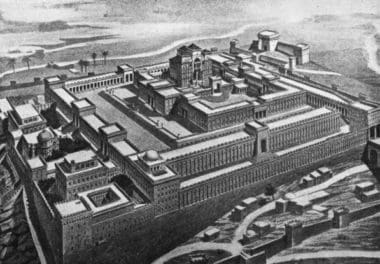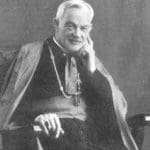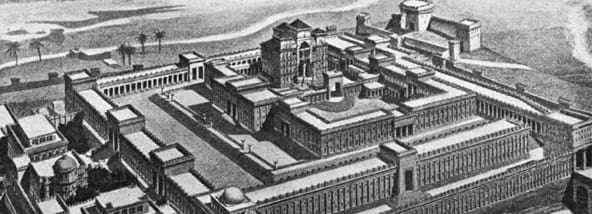“Our fathers were all under the cloud and all passed through the sea, and were all in Moses baptized in the cloud and in the sea, and did all eat the same spiritual food, and did all drink of the same spiritual drink, and they drank of the spiritual rock which followed them, and the rock was Christ. But with most of them God was not well pleased, for they were overthrown in the desert. Now these things were done in a figure to them of us. . . .All these things happened to them in figure, and they are written from correction, upon whom the ends of the world are come.” 1 Corinthians 10:1-6, 11
1. It may be safely said that the Jewish people looked upon the words of the prophets as but one source of information concerning the Christ that was to come. Perhaps even it was not the chief source; the more does this seem true if we consider the allusions that are made in the New Testament. To them their whole history was prophetic; their great heroes were prophetic; their rites and ceremonies were prophetic; in some way everything eventful seemed to foreshadow Him Who was to be the fruit and perfection of them all. As the saints who came after Him were to be His reflection, so the saints who went before Him were His anticipation.
2. Thus, to take but a few examples, in Abraham was foreshadowed His fidelity, His generosity, His obedience, His unworldliness; in Isaac His prayerfulness and His spirit of contemplation; in Jacob His patient toil, His hope, and His tenderly affectionate nature; in Joseph His unspotted purity and His ruling spirit; in Moses the Father of His people, the Lawgiver of the New Covenant, the Deliverer of the people from bondage; in Joshua the Destroyer of the enemies of God; in Samuel the Prophet of the New Covenant; in David the King of the New Kingdom; in Solomon the Builder of the New Temple; and so on through succeeding generations.
3. So, too, did the chosen people see in themselves and their history signs and figures of Him that was to come. They had been in bondage in Egypt; then this was in some way to be the lot  of the Messiah. The Nazarene was a word of consecration; then He would be called a Nazarene. The sacrifices of the Temple were of the essence of their faith, and even of their life as a nation; then of His life, also, the essential feature would be the great sacrifice. This mine is almost inexhaustible; it has certainly never been completely worked. For we could now go back upon the almost infinite series of types representing the Christ that was to be in countless ways, from the murder of Abel by his brother, the sacrifice of Isaac by his father Abraham, the selling of Joseph by his brethren, and the saving of the brethren by Joseph in return, the prayerfulness of Moses, the brazen serpent in the desert, the slaying of Goliath by David in all these the Jews before Christ found matter for contemplation.
of the Messiah. The Nazarene was a word of consecration; then He would be called a Nazarene. The sacrifices of the Temple were of the essence of their faith, and even of their life as a nation; then of His life, also, the essential feature would be the great sacrifice. This mine is almost inexhaustible; it has certainly never been completely worked. For we could now go back upon the almost infinite series of types representing the Christ that was to be in countless ways, from the murder of Abel by his brother, the sacrifice of Isaac by his father Abraham, the selling of Joseph by his brethren, and the saving of the brethren by Joseph in return, the prayerfulness of Moses, the brazen serpent in the desert, the slaying of Goliath by David in all these the Jews before Christ found matter for contemplation.
Summary Meditation Points:
1. Besides prophecy strictly so called, the Jews saw in all that went before a figure of that which was to come.
2. Thus in all their heroes, patriarchs, prophets, kings, and great men, they saw traits of the ideal Christ Who would include all.
3. And in their own history, and in many recorded details, they pondered on their significance as shadows of the future.
Editor’s Note: This meditation is from Archbishop Alban Goodier’s “The Prince of Peace” (1913).
 Art: Ideal reconstruction of the Temple of Solomon in Jerusalem according to the description from the Bible, first published in the 1st (1876—1899), 2nd (1904—1926) or 3rd (1923—1937) edition of Nordisk familjebok, PD copyright expired, Wikimedia Commons. Archbishop Alban Goodier, S.J., www.stmaryscadoganstreet.co.uk, all rights reserved, used with permission.
Art: Ideal reconstruction of the Temple of Solomon in Jerusalem according to the description from the Bible, first published in the 1st (1876—1899), 2nd (1904—1926) or 3rd (1923—1937) edition of Nordisk familjebok, PD copyright expired, Wikimedia Commons. Archbishop Alban Goodier, S.J., www.stmaryscadoganstreet.co.uk, all rights reserved, used with permission.





